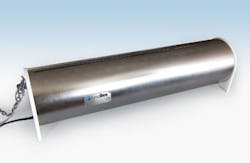Active mixing solves rural utility ice-buildup problems
It seemed like every year after its potable storage tank was constructed way back in 1972, the town of Lyons, Michigan, faced icing problems, town officials admit.
With a population of nearly 800 men, women and children, rural Lyons, found near the center of the state, today overcomes winter "ice cake" problems without lifting or lowering its tank-water levels, ensuring residents have full-strength water pressure and fire-protection flow.
Ice-cake problems start with the fact that leaving water quiescent in potable water-storage tanks can lead to thermal stratification, biofilms, excessive disinfection byproducts and disinfectant residual loss. Winter-ice formation in distribution-system reservoirs also is challenging for water utilities in colder climates.
With active mixing, stratification is forestalled because inflow water circulates throughout the entire tank because water is pulled in water from the tank bottom, where the densest layers are, and transported directly to the top of the tank.
Common enough situation
Thick ice layers often form on storage tanks surfaces during prolonged subfreezing weather. Steel tank seams can expand during ice formation, causing water leakage or structural damage. Interaction of ice chunks with inflows and outflows may further damage tanks.
According to Susan Craft, a department of public works superintendent, at one point ice damage took out the cathodic protection of Lyons’ tank. During the course of renovating that single pedestal tank, Craft consulted with Dixon Engineering of Lake Odessa, Michigan on whether a more definitive solution might be available.
The outcome was that a while back, Lyons, Michigan has a GridBee GS-12 mixer from Dickinson, North Dakota-based Medora Corp. for its potable water tank. Craft reports that from that point on, ice buildup in the tank was a thing of the past, and furthermore, doing year-round active mixing significantly improved chlorine residuals.
Passive mixing so ‘old school’
Most potable water storage tanks were specified before circulation and mixing water-quality benefits were fully appreciated. Tanks were specified with excess storage capacity for fire protection, adequate water pressure and in anticipation of future growth. Daily usage was relatively small in relation to this excess capacity, again limiting the benefits of passive mixing. Another limitation of passive mixing is that tanks have single-pipe influent-effluent designs, with the ingress-egress point typically located at the tank base.
Insufficient mixing allows water to thermally stratify within a tank. During freezing weather, temperatures in the lower portion of the water column are warmest. Groundwater, typically sourced at about 11 degrees C, as influent water, is the primary source of heat. When influent volumes are low, influent water temperature declines quickly to 3-5 degrees C. The most recently introduced water stays in the lower portion of the water column because water density is greatest at about 4 degrees C. Water temperatures in the tank decline with increasing elevation until ice forms wall-to-wall on the surface. Subsurface ice continues to form, often reaching thicknesses of one to two feet.
In Lyons, the tank’s 100,000-gallon capacity further limited passive mixing. "Our tower was too small to lower the level much during the winter," says Craft, "and because we use the height of the water for pressure, we need to keep it as full as possible. Plus, lowering water levels compromises fire-flow capacity." As a result, "ice cake" became the reality.
Overcoming horizontal layers
Active mixing is based on the simple fact that water in potable water-storage tanks naturally forms thin horizontal layers. The heaviest or densest layer is at the bottom, and each layer above it is progressively lighter.
An active mixer moves inflow water throughout the entire water body.
The Gridbee GS-12 sets on the tank floor and pulls water in at a point from one to two inches off the tank floor. In other words, it pulls in water from the very bottom of the tank, where the densest layers are, and transports it to the top of the tank. Soon, temperatures are nearly identical throughout the tank and ice cannot form.
Craft says Lyons uses the mixer year-around to combat problems from water stratification. Pulling water right off the tank floor ensures the most efficient mixing of important boundary layers ¾ without disturbing the sediment ¾ providing uniform distribution of disinfectant and uniform water age, as well as preventing stratification.
According to Craft, "I was able to keep the tank full during the winter with no icing problems. And chlorine residual levels are more consistent. I was having differing chlorine residuals before I started mixing, but now it’s been even out in the system. One sample I pull from a dead-end has maintained a real even residual."
Keeping these chlorine residual levels consistent requires less treatment, which reduces costs. And improving water quality is, of course, the ultimate goal for Lyons and its residents.
Medora Corp., Dickinson, North Dakota, whose brands include GridBee® and SolarBee®, provides mixing, THM removal and disinfectant boosting solutions to solve difficult problems in potable water treatment and storage. GridBee GS-12 mixers are certified to ANSI/NSF Standard 61, including low-lead certification, by NSF, UL, CSA or other qualifying agency. For more information, call 866-437-8076 or visit www.medoraco.com.

